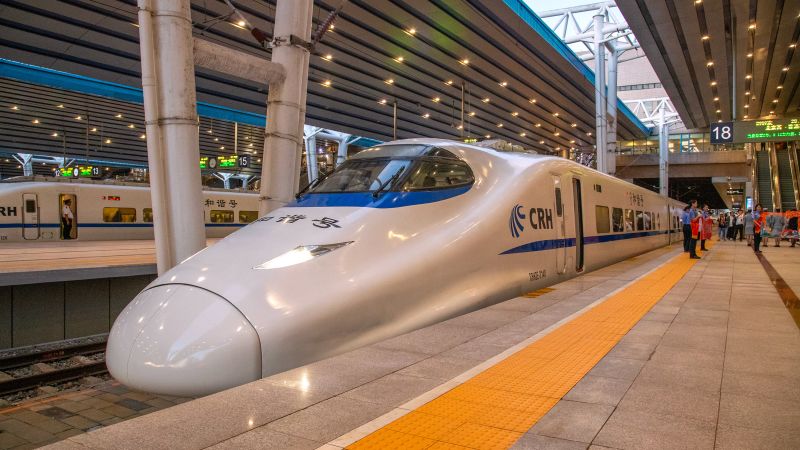Hong Kong
CNN
—
Interested in capping off your trip to Hong Kong with a long weekend in Beijing or Shanghai? A new high-speed sleeper train service is making that possibility easier than ever.
Two new overnight routes connecting the city with Beijing and Shanghai entered into service on June 15.
Both trains depart Hong Kong West Kowloon Station in the evening and arrive in Beijing at 6.53 a.m. and Shanghai at 6.45 a.m., making the journeys around 12.5 hours and 11 hours respectively. Return trips depart from Beijing and Shanghai at around 8 p.m. and arrive in Hong Kong at 8.47 a.m. and 7.29 a.m. These routes run four days a week, departing all three stations every evening from Friday to Monday.
“It will be more comfortable and faster, reducing the travel time by about half, and will cover a wider range of destinations, including popular tourist attraction cities,” John Lee, Hong Kong’s chief executive, said in a press statement, referring to the previous overnight train routes that connected Hong Kong with China’s two biggest cities.
Those intercity railway services, Beijing-Kowloon and Shanghai-Kowloon, launched in 1997. The train ride to China’s capital took around 24 hours while the journey to Shanghai was about 19 hours.
The services were suspended during the pandemic in 2020 and have been replaced by the new high-speed options that launched on June 15.
But while the new trips do indeed slash the overnight travel time by almost half, the high-speed sleeper services take slightly longer than the daytime bullet trains already in service connecting Hong Kong and the two cities in mainland China.
Currently, the train company operates one daily high-speed connection to Beijing, which takes around 8.5 hours, and one to Shanghai, which is around 7.5 hours.
Why bother with the longer journey then? The new sleeper trains might not be the fastest way to get between Hong Kong and Beijing or Shanghai, but they are a great option for business travelers who need to arrive well-rested before standard office hours, as well as leisure tourists who don’t want to waste a full day on the train or wish to save money on accommodations.
Each of the electric multiple unit (EMU) trains used to service the routes has 16 carriages, including 13 sleeper cars, two second-class seating cars and one dining car.
There are three types of seats to choose from: Second class (without a bed), sleeper and deluxe sleeper.
A standard sleeper class cabin consists of two bunk beds, sleeping four passengers, in a cabin. The deluxe version, only available on the Hong Kong-Shanghai route for now, features a bunk bed, wardrobe and sofa.
Prices range from HKD937 to HKD1,506 ($120-$193) for the Hong Kong-Beijing route and HKD682 to HKD2,128 ($88-273) for the Hong Kong-Shanghai route.
Passengers who want to book a seat can reserve their tickets on China Railway’s official ticketing site 12306.cn. Note that for trains departing from Hong Kong, you have to search “hkwestkowloon.”
International travelers can also book through ticketing platforms such as Trip.com or buy their tickets at the West Kowloon Station directly.
A joint immigration checkpoint inside West Kowloon Station allows passengers to avoid additional checks when crossing the border in and out of Hong Kong. However, travelers still need to have a valid China visa or travel document to ride the train. (Although part of China, Hong Kong is governed under a separate legal framework.)

Opened in 2018, the 26-kilometer Hong Kong high-speed railway is a part of the larger Guangzhou-Shenzhen-Hong Kong Express Rail Link (XRL).
Costing more than $10.7 billion to build, the Hong Kong section connects the city with China’s 25,000-kilometer national high-speed rail network.
But the project, which marked the first time mainland Chinese laws were given jurisdiction inside Hong Kong territory, stirred much controversy, even well before its opening.
The massive price tag, the limited traveling speed (the Hong Kong section has a maximum speed of 200 kilometers/hour – much lower than the usual 300 kilometers/hour due to its short distance) and the political implications all cast a shadow over the new railway.
Controversy aside, the introduction of the Express Rail Link provided an alternative way to travel to major Chinese cities through Hong Kong – and avoid China’s notorious flight delays.
The Hong Kong station now offers direct trips to 78 destinations around China and some 70,600 passengers use the network daily according to official figures.










